Archive for ‘Psychological’ Category
Paper Doll on The Truth(s) About Standing Desks
Are you sitting down?
That’s what we ask people when we’re about to share upsetting news. Well, if you’re sitting down, and if you tend to be sitting down much of the time, this may not be news if you’ve been paying attention the past few years, but it’s certainly upsetting.
Spending too much time at our desks, plopped down (and probably hunched over), is pretty bad for us for a number of reasons, including those illustrated in this adorable TED-Ed Talk:
Articles like Sit Less, Live Longer and Too Much Sitting May Thin the Part of Your Brain That’s Important for Memory point out the major physical and cognitive problems associated with remaining seated.
But this doesn’t get into the latest and perhaps most important research. According to science writer Gretchen Reynolds, a recent Swedish study published in the British Journal of Sports Medicine suggests that when you sit all day, your telomeres (the tiny caps on the ends of DNA strands) get shorter. Apparently, this is NOT A GOOD THING! As telomeres get shorter, the rate at which the body ages and decays speeds up. Conversely, the study found “that the telomeres in [those] who were sitting the least had lengthened. Their cells seemed to be growing physiologically younger.” Obviously, we all want young cells!
The Push for Standing Desks
So, the experts have said, STAND UP! Why? Well, they figured that for each thing that sitting does to you that’s bad, standing can reverse it.
Let’s start with ergonomics and posture. You can still slump a little when standing, but not to the same extent as when you’re sitting in a chair. So, standing can help you strengthen your core, tighten up your glutes, and strengthen other muscles. There’s also such a thing as Upper and Lower Cross Syndromes, which, when you spend too much time sitting, can lead to tension headaches, shoulder strain, and that oogy feeling of becoming one with your office chair. When you stretch your leg and torso muscles by standing, you’re a bit more fit. Or so the theory goes.
Then there’s your cardiovascular system. Standing while working increases metabolism (vs. sitting down), and the theory is that just by standing, you can reduce your risk of heart disease by increasing your blood circulation. Well, maybe.
The physical advantages of standing vs. sitting make sense. But some researchers have posited that standing has other advantages related to productivity, creativity, and cognition.
With regard to productivity, studies note that while standing, more nutrient-rich blood, more mood-enhancing hormones, and more oxygen can get to the brain. More nutrient-rich blood and oxygen means more cognition, per The Economist, and unless you’re that Danish prince, Hamlet, more thinking means more productivity. (Hamlet, however, really needed a Disney vacation, or at least a mindless afternoon Kardashian-TV.) And more mood-enhancing hormones should, logically (and up to a point), yield more creativity. Whoohoo!
Finally, while a celebrity endorsement doesn’t necessarily imply wisdom, there have certainly been some famous desk-standers, including Ernest Hemingway (who famously said, “Write drunk, edit sober,” so you have to imagine him leaning more than standing), Vladimir Nabakov, Thomas Jefferson, Charles Dickens, Virginia Woolf, and Benjamin Franklin. Good company to keep – though, come to think of it, a number of them were tipplers and likely leaning like Hemingway.
The Tide May Be Turning
Up until recently, everyone had gotten a bit rah-rah about standing desks. There’s money to be made from standing desks, and health and productivity to be gained from standing, per se, so why not try it? Well, standing is well and good, but there’s some doubt as to whether standing desks do that much for you.
Boston Public Radio rather dramatically declared Throw Away Your Standing Desk after interviewing Arthur Caplan, Director of the Division of Medical Ethics at NYU Langone Medical Center about the minimal benefits of just standing while working. (Enjoy the audio for some jokey byplay.)
Further, there’s some shocking reportage that standing desks could be making you dumber! Apparently, a recent study in the journal Ergonomics found that while “due to concerns about excessive sedentary exposure for office workers, alternate work positions,” were studied, but they found that prolonged standing may have negative “health and productivity impacts” and that while creative problem-solving did improve, “reaction time and mental state deteriorated.” Yikes.
So, the answer is, STAND UP, but don’t expect that standing desks are going to yield that many benefits.
The Best of Both Worlds
Use a standing desk if you want (but keep an eye out for muscle fatigue, swelling in your legs, ankles, or feet, and decreased in cognitive function). If your back needs more support, sit at your desk, but set a timer or use an app to remind you to get up from your desk every 45 minutes or so.
Take a brisk walk around the office, do some wall push-ups, or go outside to make a client call and enjoy some fresh air. It’s said that Aristotle’s followers, the Peripatetics, engaged in all of their philosophical discussions while ambling about the Lyceum in ancient Athens. Why not take a page out of their books (scrolls?) and propose West Wing-style walking-and-talking meetings with your colleagues instead of traditional sitting or recently-in-vogue stand-up meetings?
Chances are that movement, rather than just standing, will have a more positive effect, and a change of environment will jump-start your creativity.
Shopping for Your Solution
If you decide you must have a standing desk, Paper Doll has you covered. Really smart consumer sites like Wirecutter like the Fully line of adjustable standing desks, particularly the highly-rated Fully Jarvis Bamboo adjustable standing desk.
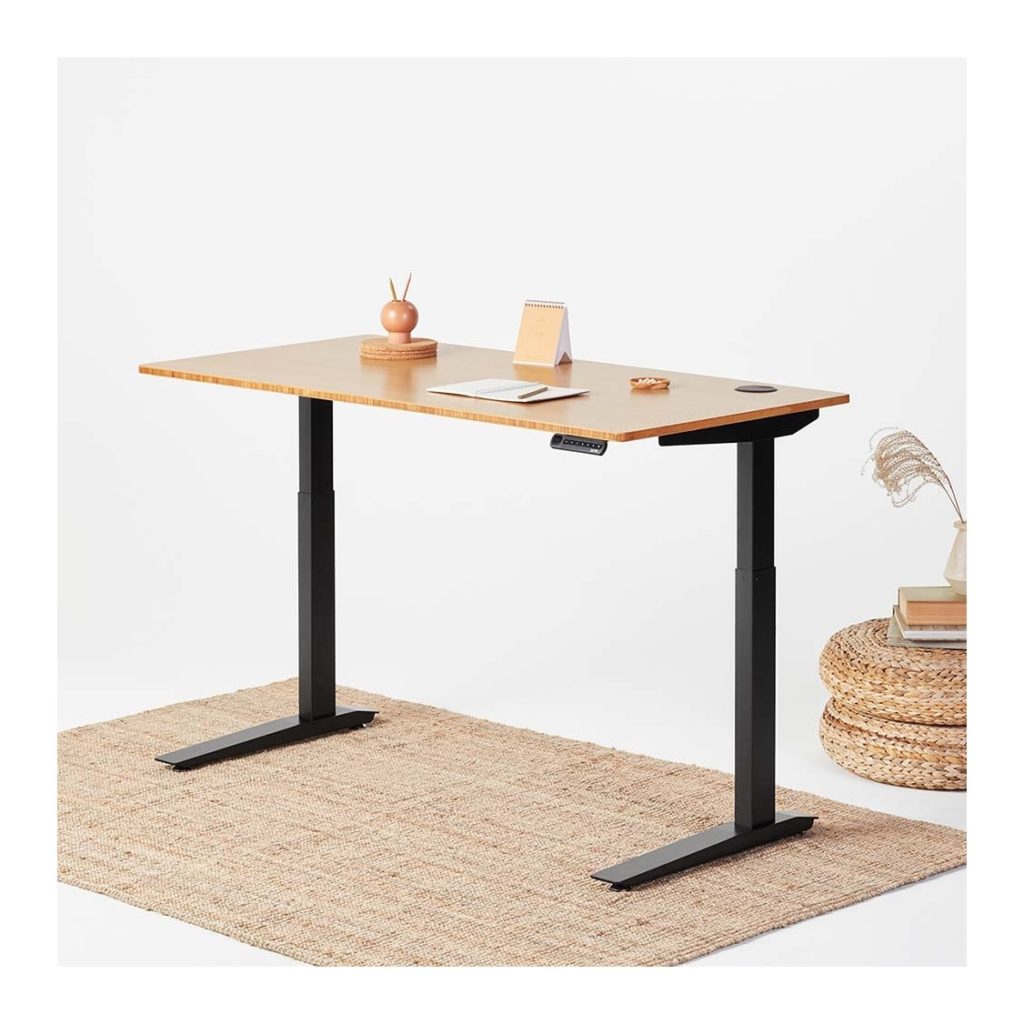
Of course, as with all furniture, prices range from high-end adjustable desks like those of Bush Business Furniture’s Stand 80 series to the DIY standing desk options and ideas on Pinterest.
Perhaps you’ve already got a desk you love. You could try what Paper Doll thinks of as a desk-topper (like a mattress pillow-topper), like HumbleWorks. The spine of the HumbleWorks has multiple slots, making it entirely adjustable. No matter your height, you can put your monitor and keyboard shelves at the correct ergonomic position for appropriate eye level and height.
The “spine” piece folds flat when not in use, so it’s easy to store.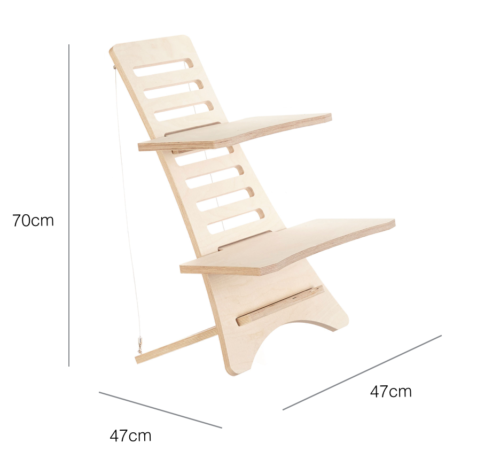
Compare different versions of the HumbleWorks standing desk. For example:
- Stan 1 is compatible with Macs and PC laptops with screens up to 15″, is made of 18mm birch plywood, and is reinforced with steel suspension cables and pins.
- Stan 1.5 is compatible with Macs and PC laptops and desktops with screens up to 17″, is made of 18mm birch plywood, and is reinforced with steel suspension cables and pins.
- Stan 2 is compatible with Macs and PC laptops and desktops with screens up to 27″, is made of 22mm birch plywood, and requires reinforcement.
If you like the wood look but want an alternative that’s more portable (and more price-sensitive) investigate the StandStand, which weighs less than many laptops and can be assembled in minutes. Versions come in bamboo or birch with varying finishes, and in multiple styles (for laptop, laptop-and-mouse, or for two monitors).
Not sure how you feel about the whole standing desk kerfuffle? Not ready to plunk down money for something that may not have a profound impact? Why not start small?
Recently, friend-of-the-blog and Professional Daily Money Manager Nanette Duffey shared her experience with the Ergodriven Spark, a sturdy cardboard standing desk that will only run you $25! It’s not gorgeous, but it gives you plenty of room for your laptop, an external keyboard and mouse, and even a knick-knack or two.
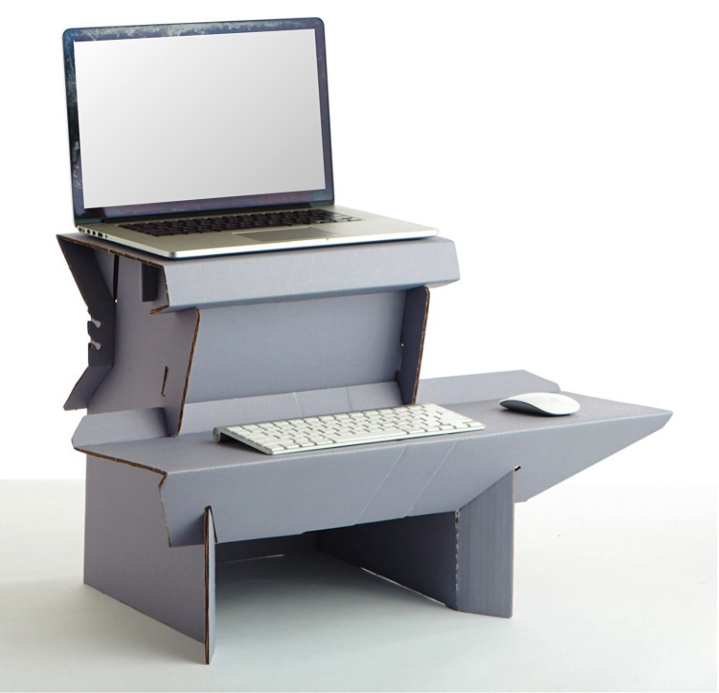
What if you want the best of all worlds? Do you want something fairly portable and full-size? Then your best bet is Refold, a sturdy, stand-up desk made out of thick cardboard! At 14 pounds, it’s not as lightweight as the Ergodriven, but it’s a free-standing desk and will hold 187 pounds! The Refolds come in three sizes: small for petite types (5’2″ and under), medium for those from 5’2″ to 6′, and large for those tall drinks of water over 6 feet.
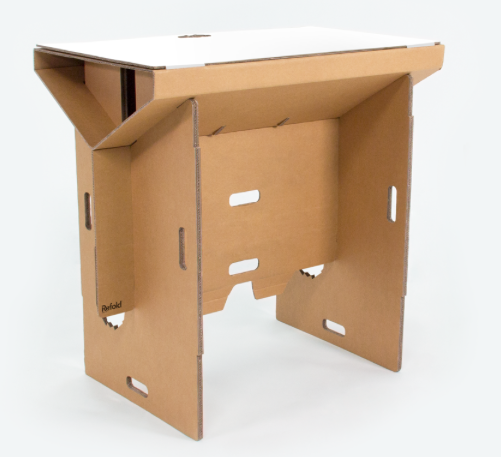
The Refold can have a cardboard or (for a teeny bit more money) a waterproof surface, can be painted or drawn on to customize it, and is fully recyclable. You can also purchase optional legs to turn it into a sitting desk for those days when you just can’t stand it!
One fairly significant note: the Refold is made in New Zealand, meaning that in addition to the $120-$190ish US dollars (depending on your product choice and the exchange rate), you’ll be paying some serious shipping charges.
Safety First
If you decide to keep on sitting, sit safely. Review these essential ergonomic tips for sitting, including:
- Sit with your feet flat on the floor.
- Keep your monitor at the same height as your line of vision.
- Sit so that your elbows are at a 90-degree bend when your hands are on the keyboard.
Finally, whether you decide to sit, stand, or work using a combination of both, make time to check that everything measures appropriately for your height. The NotSitting.com website has created an interactive sitting/standing-height desk calculator so that if you input your height, you can see the appropriate heights (whether sitting or standing) for your eyes and your elbows, and know how far your seat should be from the ground and how far your eyes should be from your monitor. For example, the following graphic shows what Paper Doll‘s ideal sitting and standing situation should be.
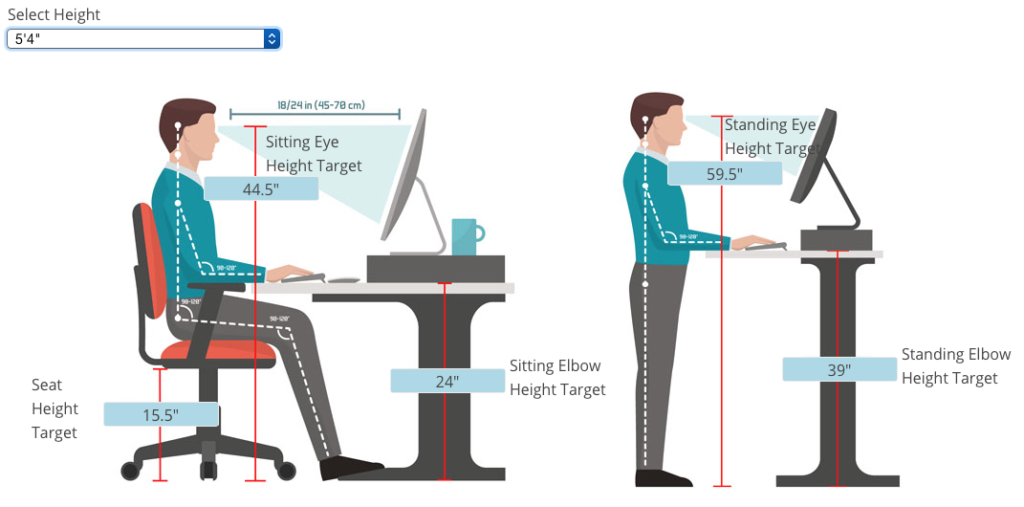
You’ve been reading this post for a while. Why not stand up, stretch, and take a walk to think about what you’ve learned?
Paper Doll’s NAPO 2016 Conference Recap: The Wisdom Edition
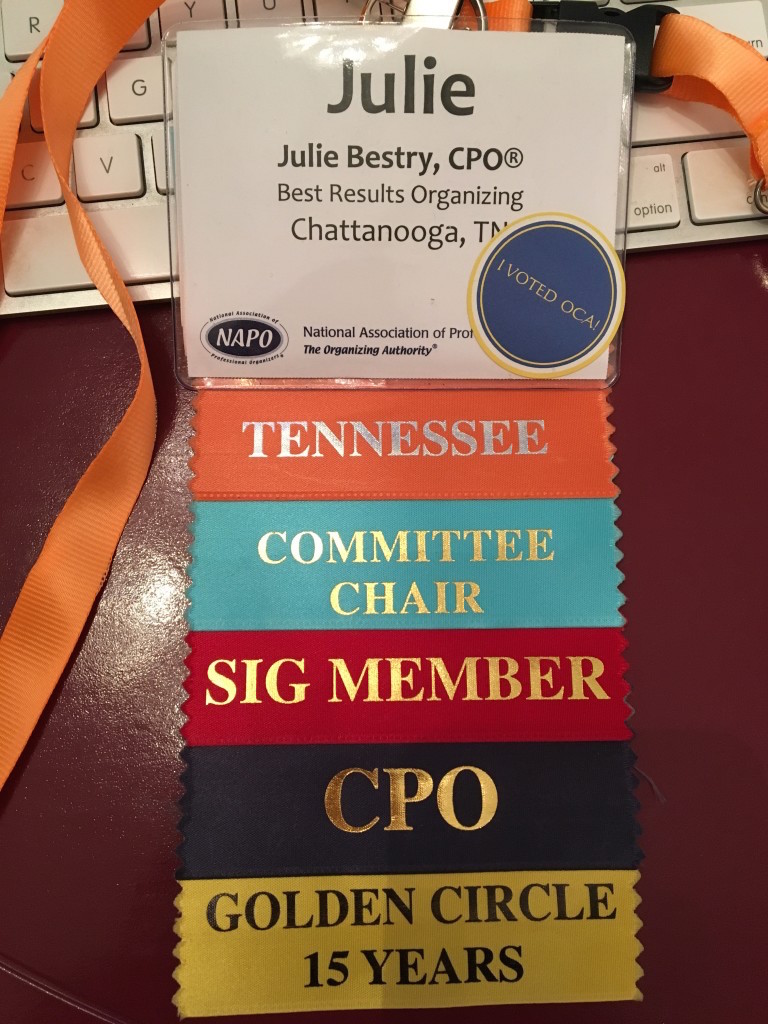
NAPO TIME!
As is the annual tradition at Paper Doll HQ, this is the time of year where we step away from paper-related topics to look at the bigger picture of what’s going on in the organizing world. The Annual Conference and Expo of the National Association of Professional Organizers was held just down the road from me this year, in Atlanta, GA.
 The atmosphere as everyone starts arriving at a NAPO conference is like the first day of summer camp — or a college reunion. We’ve all seen each other on social media, but it’s a delight to view my colleagues when they’re bigger than their one-centimeter high avatars.
The atmosphere as everyone starts arriving at a NAPO conference is like the first day of summer camp — or a college reunion. We’ve all seen each other on social media, but it’s a delight to view my colleagues when they’re bigger than their one-centimeter high avatars.
The first full day is all about preliminary, but important, activities. On Wednesday morning, I attended the Angela F. Wallace Leadership Forum, where we learned techniques and strategies for encouraging and motivating volunteers. In the afternoon, I participated in lively discussions at our meeting of the Board of Certification for Professional Organizers, for which I serve as the Director of Program Development (also known as the Sacred Keeper of All Rules Persnickety) and as the local grammar and spelling cop.
SETTING THE TONE
Our opening keynote speaker, Scott Greenberg, presented The Third Factor: The Mindset for High-Performance Leadership.
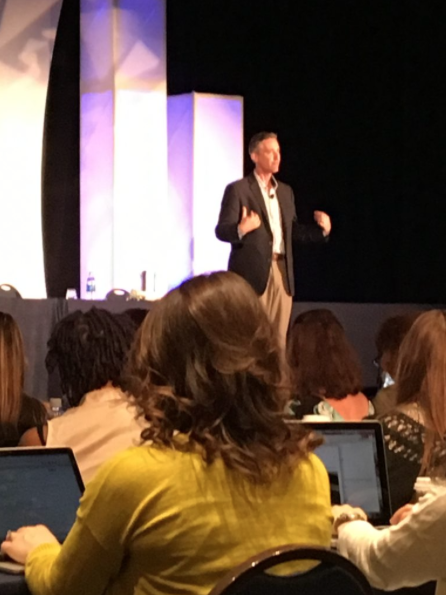
Scott spoke about the three factors that influence success:
- External factors that we can’t personally control, like the economy, what our competition does, the weather, our own DNA,
- Operational factors, over which we have a bit of control, like if we work long enough and hard enough,
- Mindset, or how we think about things, and whether we have a fixed mindset (and believe that we have little-to-no control over our own qualities) vs. a growth mindset, one in which we can improve and grow.
Scott talked about the importance of making interpersonal connections and having gratitude, but my biggest takeaway from his motivational presentation was that it’s not just about the tangible (or even temporal) clutter, but about the “head trash” piled up by our mental hecklers. Scott encouraged us to externalize what these internal hecklers were saying to us so that we could fully appreciate the flaws inherent when we are deprecating ourselves. If you followed any of the tweets from our #NAPO2016 hashtag, you would have seen how much we all embraced Scott’s parting wisdom:
EDUCATIONAL SESSIONS
After the welcome and keynote, we moved on to the meat of our conference sustenance: our concurrent educational sessions, where, over the course of three days, we have the choice of attending one of five classes in each of six concurrent sessions. Somehow, just going to six out of thirty amazing presentations does not seem like enough!
While I work with residential as well as business clients, this year, my focus was on technology and productivity. Courses I took included:
The Art of Tactical Time Management — If you don’t follow the blog and podcast of Mike Vardy, the Productivityist, you’re truly missing out. Perhaps Mike’s presentation resonated with me so much is because it dovetails with what I teach my own clients. For example:
You’ve heard me say this before — if we try to keep things in our heads, or if we leave tangible items out (on our desks, and around our computers, and blocking our doors) to trigger us to think of something, that’s all we do. We think of them, but the energy we waste on remembering something and thinking of it, instead of about it, contextually, is wasted energy. Capture it — write it down on paper or save the thought digitally — and then you can move forward toward your goals.
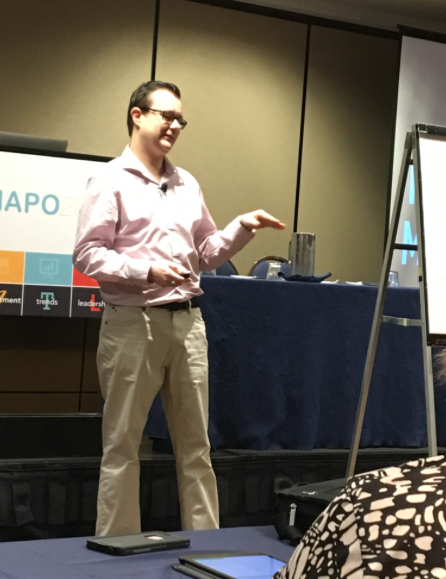
Mike also talked about “time theming” similar to the task-and-time blocking I discussed in my book, 57 Secrets to Organizing Your Small Business (the revised and newly named edition of which will be out later this year). Mike’s time theming (for the year, the month, and the days of the week) is central to his NOW Year Method, about which we learned extensively in the session. I won’t give out those details and spoil Mike’s brilliance — you definitely want to check him out, but I’ll leave you with another of his bon mots.
Other sessions I attended included:
The Paradox of Technology in Business (and Life), in which Nadine Seidman, MSW, MPA, and Nancy Kruschke, CPO®, looked beyond the benefits of technology (communication and collaboration, mobility, and productivity) to the darker costs of technology, including financial (initial and ongoing), physical/health (sleep interruption, neck and back pain), societal (reduced privacy and diminution of etiquette), and psychological (depression, anxiety, and overwhelm). Nadine and Nancy shared great tips for professionals to create “response time policies” for setting expectations for how often, when, and by whom business replies will be made, and encouraged us to unplug ourselves, personally, to recharge. (Just be sure you wait until after you finish reading this post.)
Achieving Balance and Creating Peace with Organizing, where my colleagues Amy Trager, CPO®, and Suzy Margolis Hart used philosophies from the practice of yoga to discuss how we might work better with our organizing and productivity clients. As I once explained on a Smead EZ Grip product testimonial video, Paper Doll has weak, wimpy wrists and appreciates, rather than practices, yoga. However, the messages of this session, from the philosophical — “There is no perfect” — to the practical — how to be non-judgmental, reduce unpleasantness, improve flow, and maintain boundaries — are things we can all use in our work and daily lives.
Down With Digital Clutter, taught by my colleague Pam Holland, seemed to bookend the class on the paradox of technology, and offered up a cornucopia of advice and tools on how to eliminate the clutter that technology builds up. I liked that Pam went against the modern grain (as I do), championing the idea of organizing and building infrastructure for your digital files instead of relying on search technology. My favorite tip, however, and one I intend to keep reminding myself, was that it’s important to remember to empty ALL of the trash. Just as my residential clients are good at remembering to take out their big (usually kitchen) trash on garbage day, while neglecting the tiny bedroom, office, and bathroom trash cans, we all tend to forget that our computers and digital devices have multiple trash cans — not just our desktops, but our emails, our photo collections, and our individual apps, and if they go unemptied, we waste our resources.
Of course, not all of the educational sessions I took were for helping my clients be more productive. The title of my friend and colleague Deb Lee’s Content Marketing: Blogging Tips for Your Small Business practically damns with faint praise what was a 90-minute master class in creating, researching, writing, promoting, and excelling at blogging.
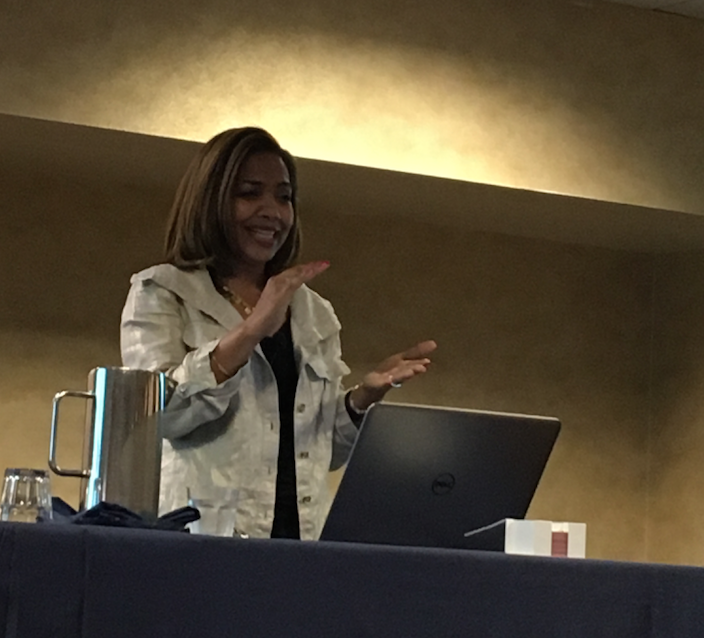
If you are a small business person (or a big business person), there’s nobody better from whom you can learn how to promote your business — so be sure to check out her newly updated D. Allison Lee website to see how her productivity and technology coaching can rock your world. (Nope, this isn’t a paid promotion. Deb is just THAT good that everyone should know about her.)
For those who were interested in other topics, NAPO had them covered with a variety of tracks for classes I’ve not yet mentioned, including:
Business Growth, Marketing, Leadership: Imperfection Rules! Creative Ways to Run Your Business; Coaching Works: Coaching Meets the Organizing World; How to Be an Independent Contractor; Veteran Forum Interactive; How To Keep Your Business from Becoming theIRS! [sic]; What’s Next? Planning an Effective Business Exit Strategy; Strategic Planning to Grow Your Business; Leveraging a Competitive Market: Building Your Personal Brand
Organizing and Productivity: Closets, Pantries, Cabinets, Offices: Beyond the Basics; Photo Organizing Anxiety and How To Overcome It; Transparent Power: Improve Client Outcomes through Direct Communication; Holistic Time Management; Information Afterlife and the Digital Estate Plan
Specific Needs Clients: Still Someone: Organizing Older Adults with Memory Loss; ADHD in the Family: How to Really Help; Play! The Secret Ingredient to ADHD Motivation
Research: Industry Statistics and Trends; Booming Your Baby Boomer Business: Research-based Understanding of this Pivotal Age Group
Special Interest Groups: Moving Made Easy; How Organizers Engage Students; Seven Truths to Becoming a Published Author
Trends, Technology, and Social Media: Power of Email Marketing for Today’s Savvy Organizer; Digital Eyes: Storytelling through Video Marketing; Profit and Value with Online Training
Even if you’re not a professional organizer, I bet you’re envious now!
FOOD, GLORIOUS FOOD (AND KARAOKE)
We professional organizers and productivity specialists take plenty of time to refresh our brains with rest and relaxation — just as we advise our clients. For years, our NAPO meals were almost all taken together, seated at round tables in large ballrooms where the noise and overcrowding made convivial conversation difficult. (It also explains why I had laryngitis by the last day of our conference ever year.)
And let’s be real. Conference food is generally both uninspired and uninspiring. For vegetarians and others with special food requirements, conference dining has also often been a disappointment. (A plate of steamed bok choi does not a meal make!) However, this year, the Atlanta Sheraton did an amazing catering job, and our meals were far superior to anything I’d been served in my last decade and a half of attendance. Still, the hotel could not handle our volume in the traditional way, so we had more buffets and even got to lunch al fresco by the pool.
My favorite addition to our meal experience was this year’s Dine-Around experiment, where attendees could sign up to eat in small groups at any of a number of local restaurants within walking distance from the hotel. I was amused to find that although I’d arrived two days before the official start of conference and was only the sixth person to sign up for a Turkish meal at Atlanta’s Truva, I was the third Julie. Hence, this photo caption:
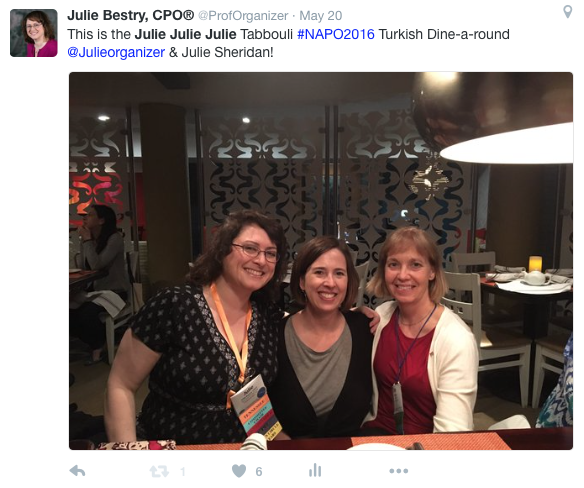
And be assured, lest you imagine that our professional organizing community’s lightheartedness extends only to culinary sustenance, let me disabuse you of that thought. Our NAPO President, Ellen Faye, opened the President’s Reception to all attendees this year for a “Black & White” party that included dancing and karaoke.
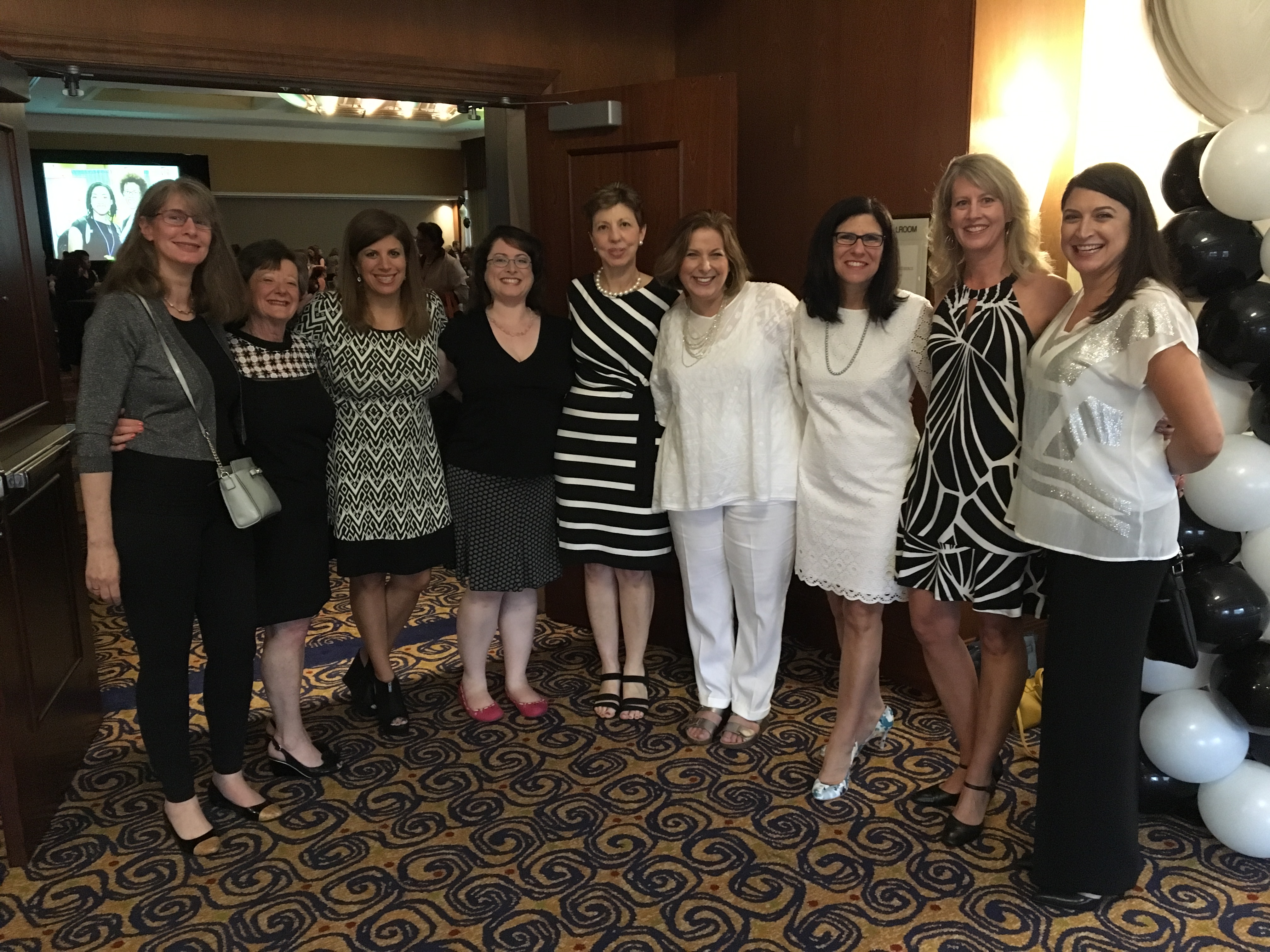
So, while we value our education, professionalism, and camaraderie, don’t ever believe the stereotype that professional organizers are stuffy.
In the upcoming NAPO re-cap posts, we’ll be looking at the products and vendors who can help make your life more organized, including the 2016 winners of the NAPO Organizers’ Choice Awards.
Paper Doll Talks With Smead About Fear & Disorganization

Getting organized can be scary.
Let that idea sink in. Usually, we talk about getting organized from the perspective of practical matters. What’s the most efficient technique? What’s products can streamline the process?
When we do talk about the psychology of getting organized, we’re often focusing on tips and tricks to get us motivated, to eliminate procrastination, or to keep us focused on a system, but we don’t necessarily dig into the idea that there are baseline fears, often unacknowledged, that prevent us from taking the steps we know will improve our lives.
This week, I sat down with John Hunt, host of Smead’s Keeping You Organized video podcast to record a show called “Fears That Keep You From Getting Organized.”
On the show, we talked about some of the fears — unspoken or even unrecognized — that cause us to back away from our organizing challenges without really considering the solutions available. Some of these include:
- Fear of discarding something — whether tangible or informational — because you worry that you might need someday. We call this the “just in case” fear.
- Fear of stifling your creativity
- Fear of potential emotional distress after discarding something
- Fear of losing personal or sentimental attachments to people and memories
- Fear of letting go of things upon which you’ve lavished money, time, or attention — otherwise known as the “sunk cost” fallacy
- Fear of the unknown
Of course, there are other fears that prevent us from achieving our organizing and productivity goals that we didn’t even get to, including:
- Fear of failure — “What if I spent time trying to create order and it turns out I can’t do it? Or I can’t maintain it?”
- Fear of success — “If I declutter and get more organized, people are going to expect more from me and heap more work and responsibilities on my shoulders.”
- Fear of loss of serendipity — “Right now, I’m delighted and surprised when I spend hours searching for something I can’t find, but come across something under a pile that I was looking for last week, or six months ago.”
There are all kinds of fears. I believe that when we acknowledge our fears, we’re taking the first step toward recognizing that we have control over whether to give in to the inertia of fear or break through and empower ourselves for change. I’d love to hear your thoughts on fear and disorganization.
Check out the above video, or if you prefer, you can listen to the audio version of the Smead podcast.

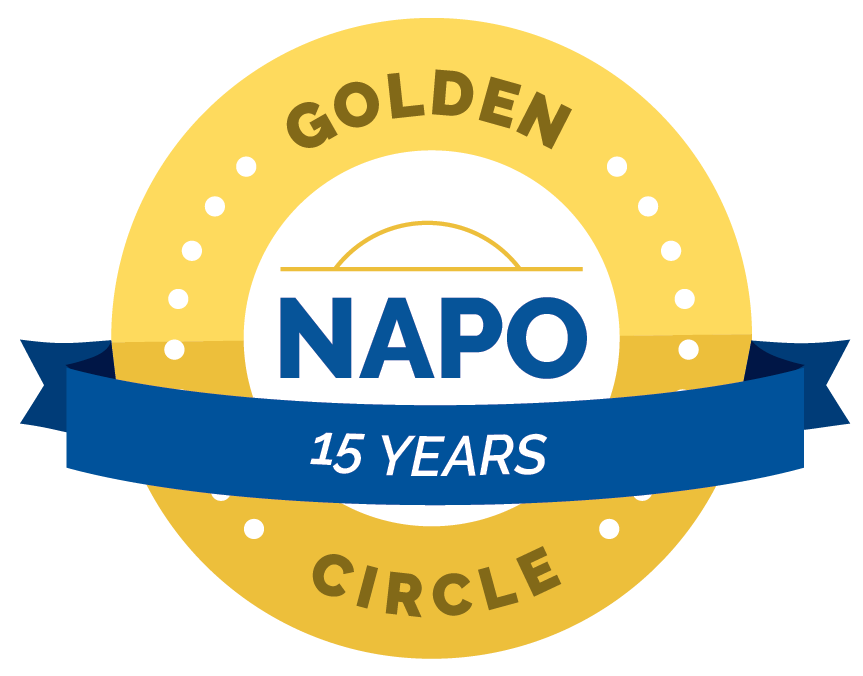
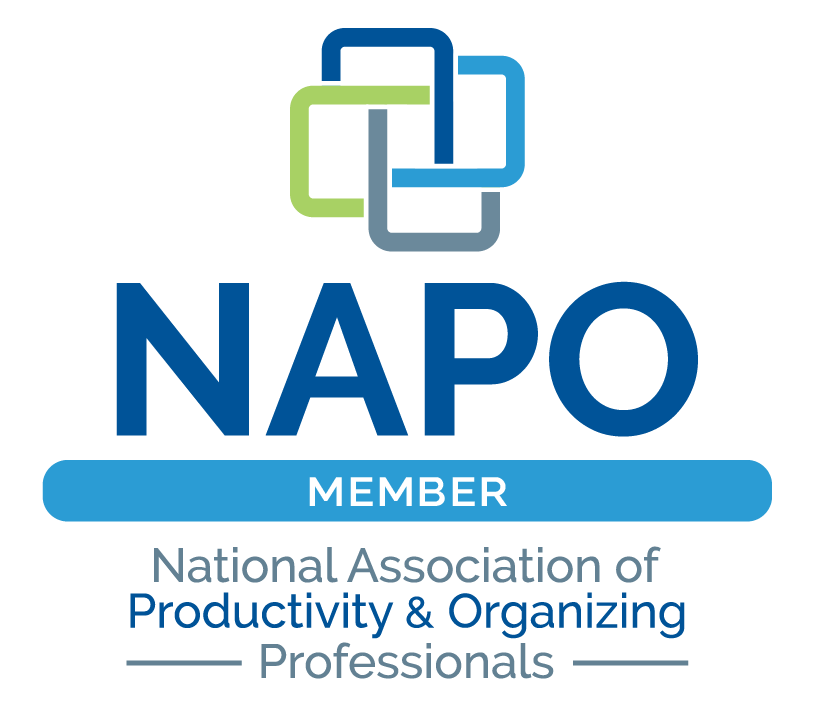
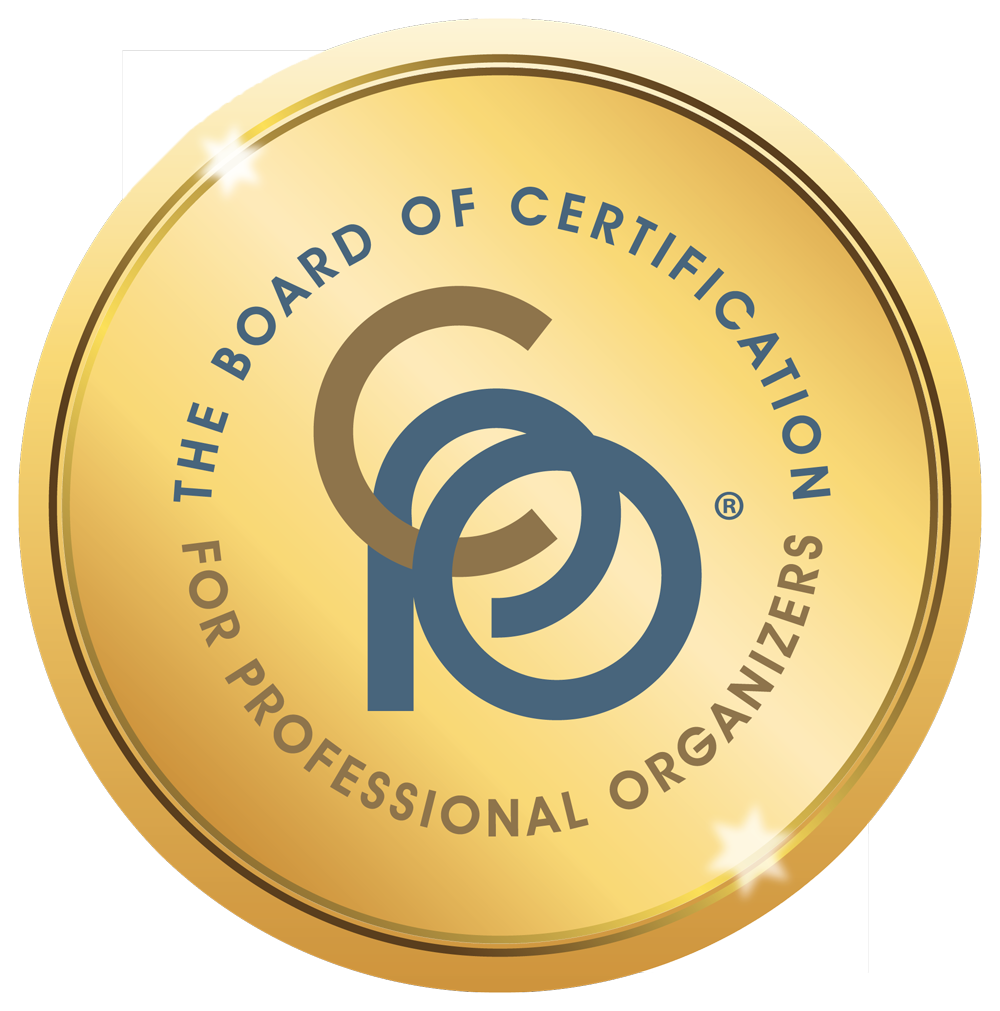
Follow Me